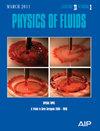高重组分原油的乳化特性及其在多孔介质中的乳化机理
IF 4.1
2区 工程技术
Q1 MECHANICS
引用次数: 0
摘要
吉木萨尔地区有压裂关井后原油乳化的现象,但乳化特征和机理仍不清楚。本研究采用低场核磁共振技术和目视微位移试验来研究原油的乳化特征及其在多孔介质中的乳化机理。实验结果表明,重组分(沥青质和树脂)通过增加油相中水滴的粘滞力,影响油相中小水滴的尺寸和稳定性,从而增强原油乳化作用。在流经孔喉的过程中,乳状液主要通过拉伸和折断作用形成,拉伸作用更倾向于形成较小液滴尺寸的乳状液,而折断作用则会将较大的油滴分成两个较小的油滴。导致大油滴被拉伸成小油滴的主要因素包括油滴成分的变化、外部张力以及这些作用在油滴上的力的持续时间。毛细力会在孔隙尺度上乳化原油和水,导致吸收率降低。然而,当毛细力足够强大,水相能够渗透并突破乳化层时,吸收率就会恢复。这项研究为了解乳化淹没机制的适应性提供了宝贵的见解。本文章由计算机程序翻译,如有差异,请以英文原文为准。
Emulsification characteristics of crude oil with a high content of heavy components and its emulsification mechanism in porous media
There are occurrences of crude oil emulsification following the fracturing shut-in wells in the Jimushar, but the emulsification characteristics and mechanism remain unclear. In this study, the low-field nuclear magnetic resonance technique and visual microdisplacement tests are employed to investigate the emulsification characteristics of crude oil, along with its emulsification mechanism in porous media. Experimental results revealed that the heavy components (asphaltene and resin) enhance crude oil emulsification by increasing the viscous force of water droplets in the oil phase, affecting the size and stability of small water droplets in the oil phase. In the process of flowing through pore throats, emulsions are formed primarily by stretching and snap-off action, with stretching preferring to form smaller droplet-size emulsions, while snap-off results in the division of larger oil droplets into two smaller ones. The primary factors causing a large oil droplet to be stretched into smaller droplets include changes in the composition of the oil droplet, external tension, and the duration of these forces acting on the droplet. Capillary forces can emulsify crude oil and water at the pore scale, resulting in a reduction of the absorption rate. However, this rate can be restored when the capillary forces are strong enough for the water phase to penetrate and break through the emulsified layer. This study offers valuable insights into understanding the adaptability of the emulsification flooding mechanism.
求助全文
通过发布文献求助,成功后即可免费获取论文全文。
去求助
来源期刊

Physics of Fluids
物理-力学
CiteScore
6.50
自引率
41.30%
发文量
2063
审稿时长
2.6 months
期刊介绍:
Physics of Fluids (PoF) is a preeminent journal devoted to publishing original theoretical, computational, and experimental contributions to the understanding of the dynamics of gases, liquids, and complex or multiphase fluids. Topics published in PoF are diverse and reflect the most important subjects in fluid dynamics, including, but not limited to:
-Acoustics
-Aerospace and aeronautical flow
-Astrophysical flow
-Biofluid mechanics
-Cavitation and cavitating flows
-Combustion flows
-Complex fluids
-Compressible flow
-Computational fluid dynamics
-Contact lines
-Continuum mechanics
-Convection
-Cryogenic flow
-Droplets
-Electrical and magnetic effects in fluid flow
-Foam, bubble, and film mechanics
-Flow control
-Flow instability and transition
-Flow orientation and anisotropy
-Flows with other transport phenomena
-Flows with complex boundary conditions
-Flow visualization
-Fluid mechanics
-Fluid physical properties
-Fluid–structure interactions
-Free surface flows
-Geophysical flow
-Interfacial flow
-Knudsen flow
-Laminar flow
-Liquid crystals
-Mathematics of fluids
-Micro- and nanofluid mechanics
-Mixing
-Molecular theory
-Nanofluidics
-Particulate, multiphase, and granular flow
-Processing flows
-Relativistic fluid mechanics
-Rotating flows
-Shock wave phenomena
-Soft matter
-Stratified flows
-Supercritical fluids
-Superfluidity
-Thermodynamics of flow systems
-Transonic flow
-Turbulent flow
-Viscous and non-Newtonian flow
-Viscoelasticity
-Vortex dynamics
-Waves
 求助内容:
求助内容: 应助结果提醒方式:
应助结果提醒方式:


